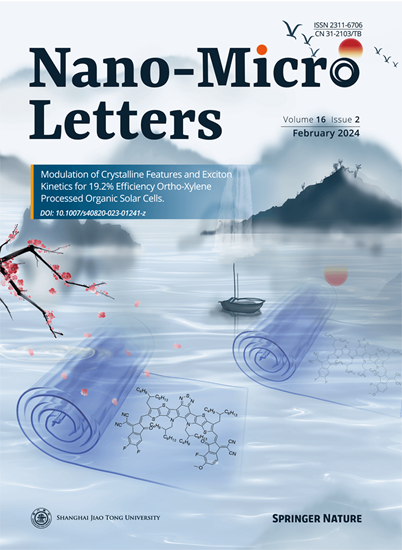Nature-Inspired Upward Hanging Evaporator with Photothermal 3D Spacer Fabric for Zero-Liquid-Discharge Desalination.
IF 36.3
1区 材料科学
Q1 Engineering
引用次数: 0
Abstract
While desalination is a key solution for global freshwater scarcity, its implementation faces environmental challenges due to concentrated brine byproducts mainly disposed of via coastal discharge systems. Solar interfacial evaporation offers sustainable management potential, yet inevitable salt nucleation at evaporation interfaces degrades photothermal conversion and operational stability via light scattering and pathway blockage. Inspired by the mangrove leaf, we propose a photothermal 3D polydopamine and polypyrrole polymerized spacer fabric (PPSF)-based upward hanging model evaporation configuration with a reverse water feeding mechanism. This design enables zero-liquid-discharge (ZLD) desalination through phase-separation crystallization. The interconnected porous architecture and the rough surface of the PPSF enable superior water transport, achieving excellent solar-absorbing efficiency of 97.8%. By adjusting the tilt angle (θ), the evaporator separates the evaporation and salt crystallization zones via controlled capillary-driven brine transport, minimizing heat dissipation from brine discharge. At an optimal tilt angle of 52°, the evaporator reaches an evaporation rate of 2.81 kg m-2 h-1 with minimal heat loss (0.366 W) under 1-sun illumination while treating a 7 wt% waste brine solution. Furthermore, it sustains an evaporation rate of 2.71 kg m-2 h-1 over 72 h while ensuring efficient salt recovery. These results highlight a scalable, energy-efficient approach for sustainable ZLD desalination.自然启发的上吊蒸发器与光热三维间隔织物零液体排放海水淡化。
虽然海水淡化是全球淡水短缺的关键解决方案,但由于集中的盐水副产品主要通过沿海排放系统处理,其实施面临环境挑战。太阳界面蒸发提供了可持续的管理潜力,但蒸发界面上不可避免的盐成核会通过光散射和路径阻塞降低光热转换和操作稳定性。受红树林叶片的启发,我们提出了一种基于光热3D聚多巴胺和聚吡咯聚合空间织物(PPSF)的上吊模型蒸发配置,具有反向给水机制。该设计通过相分离结晶实现了零液体排放(ZLD)海水淡化。相互连接的多孔结构和粗糙的表面使PPSF具有优越的水输送能力,实现了97.8%的优异太阳能吸收效率。通过调节倾斜角度(θ),蒸发器通过控制毛细管驱动的盐水输送将蒸发区和盐结晶区分开,最大限度地减少了盐水排放的散热。在最佳倾角为52°时,蒸发器在1个太阳光照下的蒸发速率为2.81 kg m-2 h-1,热损失最小(0.366 W),同时处理7 wt%的废盐水溶液。此外,它在72 h内保持2.71 kg m-2 h-1的蒸发速率,同时确保有效的盐回收。这些结果突出了可持续ZLD脱盐的可扩展、节能方法。
本文章由计算机程序翻译,如有差异,请以英文原文为准。
求助全文
约1分钟内获得全文
求助全文
来源期刊

Nano-Micro Letters
NANOSCIENCE & NANOTECHNOLOGY-MATERIALS SCIENCE, MULTIDISCIPLINARY
CiteScore
32.60
自引率
4.90%
发文量
981
审稿时长
1.1 months
期刊介绍:
Nano-Micro Letters is a peer-reviewed, international, interdisciplinary, and open-access journal published under the SpringerOpen brand.
Nano-Micro Letters focuses on the science, experiments, engineering, technologies, and applications of nano- or microscale structures and systems in various fields such as physics, chemistry, biology, material science, and pharmacy.It also explores the expanding interfaces between these fields.
Nano-Micro Letters particularly emphasizes the bottom-up approach in the length scale from nano to micro. This approach is crucial for achieving industrial applications in nanotechnology, as it involves the assembly, modification, and control of nanostructures on a microscale.
 求助内容:
求助内容: 应助结果提醒方式:
应助结果提醒方式:


